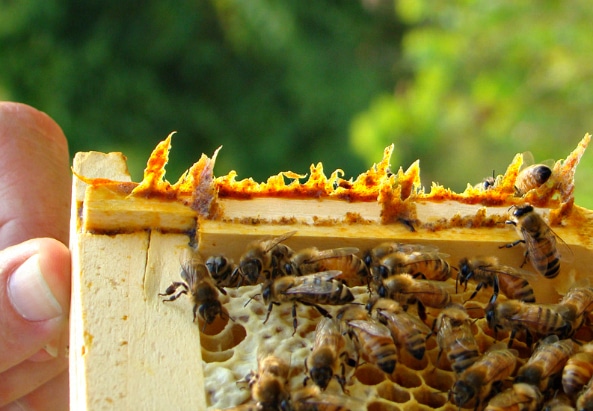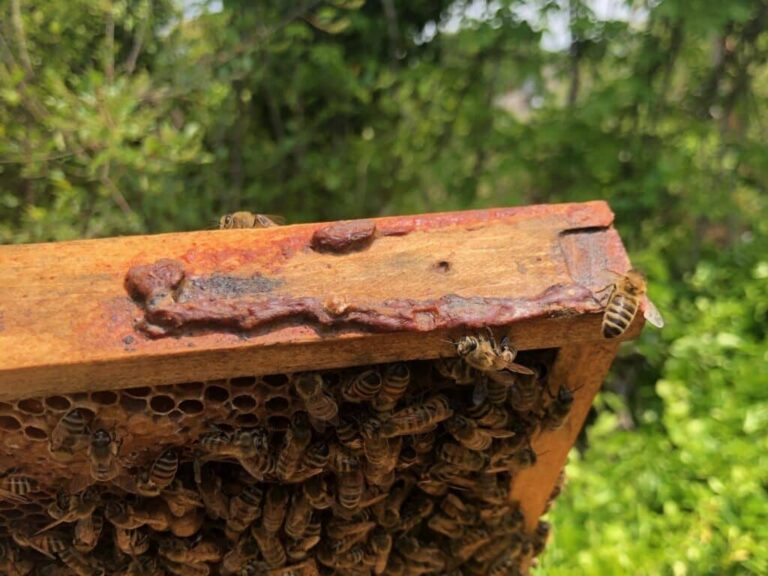Bee propolis is a resinous substance collected and produced by honey bees from tree buds, sap, and other botanical sources, which the bees mix with their saliva and beeswax. Bees use propolis to seal cracks and crevices in their hives, protect the hive from intruders and pathogens, and maintain optimal hive environment by controlling airflow and humidity.
Importance and functions:
- Protective barrier: In the hive, propolis acts as a defense mechanism, keeping out bacteria, viruses, fungi, and small invaders, thereby maintaining colony health. This function is so crucial that bees collect more propolis when the colony is at risk or sick, exemplifying collective “social immunity”.
- Antimicrobial action: Propolis contains potent compounds, including flavonoids and phenolics, which have strong antibacterial, antifungal, antiviral, and even antiparasitic properties. These properties not only protect the hive but have also made propolis valuable in traditional and modern medicine.
Origin:
- Honey bees gather plant resins (mainly from poplar and other trees) and mix them with their own secretions and beeswax to make propolis.
- The composition depends on the local flora but typically includes about 50% tree and vegetable resins, 30% beeswax, 5% pollen, and 10% essential oils.
Benefits for humans:
- Anti-inflammatory: Propolis reduces inflammation by inhibiting inflammatory cytokines.
- Immune-boosting: It has immune-modulating effects, helping the body combat infections.
- Wound healing: People have used propolis topically to help heal minor wounds, burns, and cold sores due to its antimicrobial and tissue-regenerating actions.
- Oral health: Its antibacterial qualities make it beneficial in promoting oral hygiene, treating or preventing oral infections, and soothing sore throats.
- Additional potential: Recent research suggests possible anti-cancer, antifungal (e.g., against Candida), and antiparasitic benefits, although more evidence in humans is needed.
What are the main plant sources bees use to produce propolis?
The main plant sources bees use to produce propolis vary by region and local vegetation, but the most important are:
- Poplar species (Populus spp.): In temperate zones across Europe, North America, Asia, New Zealand, and the continental part of Australia, resins from poplar buds are the primary source for what is known as “poplar-type” propolis.
- Birch (Betula spp.): Particularly in northern regions like Russia, where poplars may be scarce, bees gather resin from birch buds (Betula verrucosa and Betula pendula).
- Pine (Pinus spp.): Pines can also contribute significant resin to propolis in many temperate areas.
- Other temperate trees: Additional plants providing resins include alder (Alnus glutinosa), horse chestnut (Aesculus hippocastanum), elm (Ulmus spp.), ash (Fraxinus spp.), oak (Quercus spp.), beech (Fagus spp.), willow (Salix alba), and various Prunus and Acacia species.
- Tropical and subtropical sources: In tropical regions, propolis composition shifts.

In summary, bee propolis is important for both bee hive health (serving as a physical and antimicrobial barrier) and potentially for human health due to its anti-inflammatory, antimicrobial, and immune-modulating properties, with a historical and growing modern use as a natural remedy. The main plant sources are poplar, birch, pine, and a variety of other local trees and shrubs, with the precise botanical origin varying by geography and flora. Bees collect resins from tree buds, bark, leaves, and occasionally flowers to create propolis.
Images by Pexels / Pixabay
Ad – Amazon Associate
- DELIVERS 1220 MG PER SERVING. Propolis is a resinous substance produced by honeybees to protect…
- PURE HIVE POWER: Beekeeper’s Naturals Superfood Honey combines sustainably sourced ingredients of…




